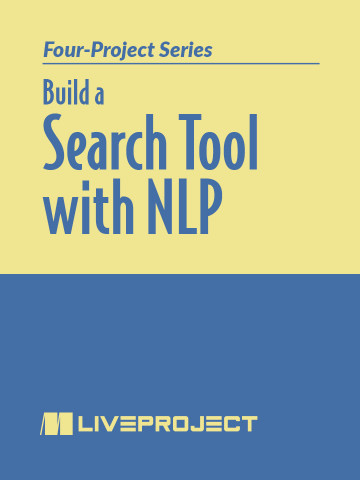- prerequisites
- intermediate Python • basic scikit-learn • basic Docker • natural language processing tokenization • lemmatization • cleaning of text data
- skills learned
- build an inverted index • question-answering tasks with pretrained BERT models • search and indexing with Elasticsearch
pro $24.99 per month
- access to all Manning books, MEAPs, liveVideos, liveProjects, and audiobooks!
- choose one free eBook per month to keep
- exclusive 50% discount on all purchases
- renews monthly, pause or cancel renewal anytime
lite $19.99 per month
- access to all Manning books, including MEAPs!
team
5, 10 or 20 seats+ for your team - learn more

In this series of liveProjects, you’ll build a custom search engine that’s capable of quickly and accurately sourcing documents from the CDC’s document database. Your search engine will improve the CDC’s ability to handle future pandemics, with the capability to aggregate and search unstructured text data from records of earlier outbreaks. Each liveProject in this series tackles a different aspect of searching with natural language processing so you can pick and choose the specific skills you need.
here's what's included





team
- five seats for your team
- access to all Manning books, MEAPs, liveVideos, liveProjects, and audiobooks!
- choose another free product every time you renew
- choose twelve free products per year
- exclusive 50% discount on all purchases
- renews monthly, pause or cancel renewal anytime
- renews annually, pause or cancel renewal anytime
-
![]() Build a Search Tool with NLP project for free
Build a Search Tool with NLP project for free
Prerequisites
This liveProject is for intermediate Python programmers familiar with the basics of manipulations with strings, lists and dictionaries. To begin this liveProject, you will need to be familiar with the following:
TOOLS
- Intermediate Python
- Basic understanding of conda environments
- Basic scikit-learn
- Basic NumPy
- Reading data from and writing to JSON files
- Manipulations with tuples, lists and dictionaries using loops and comprehensions
- Natural language processing tokenization, lemmatization, and cleaning of text data
- Basic NumPy array operations
 features
features
- Self-paced
- You choose the schedule and decide how much time to invest as you build your project.
- Project roadmap
- Each project is divided into several achievable steps.
- Get Help
- While within the liveProject platform, get help from fellow participants and even more help with paid sessions with our expert mentors.
- Compare with others
- For each step, compare your deliverable to the solutions by the author and other participants.
- book resources
- Get full access to select books for 90 days. Permanent access to excerpts from Manning products are also included, as well as references to other resources.
 Build a Search Tool with NLP project for free
Build a Search Tool with NLP project for free